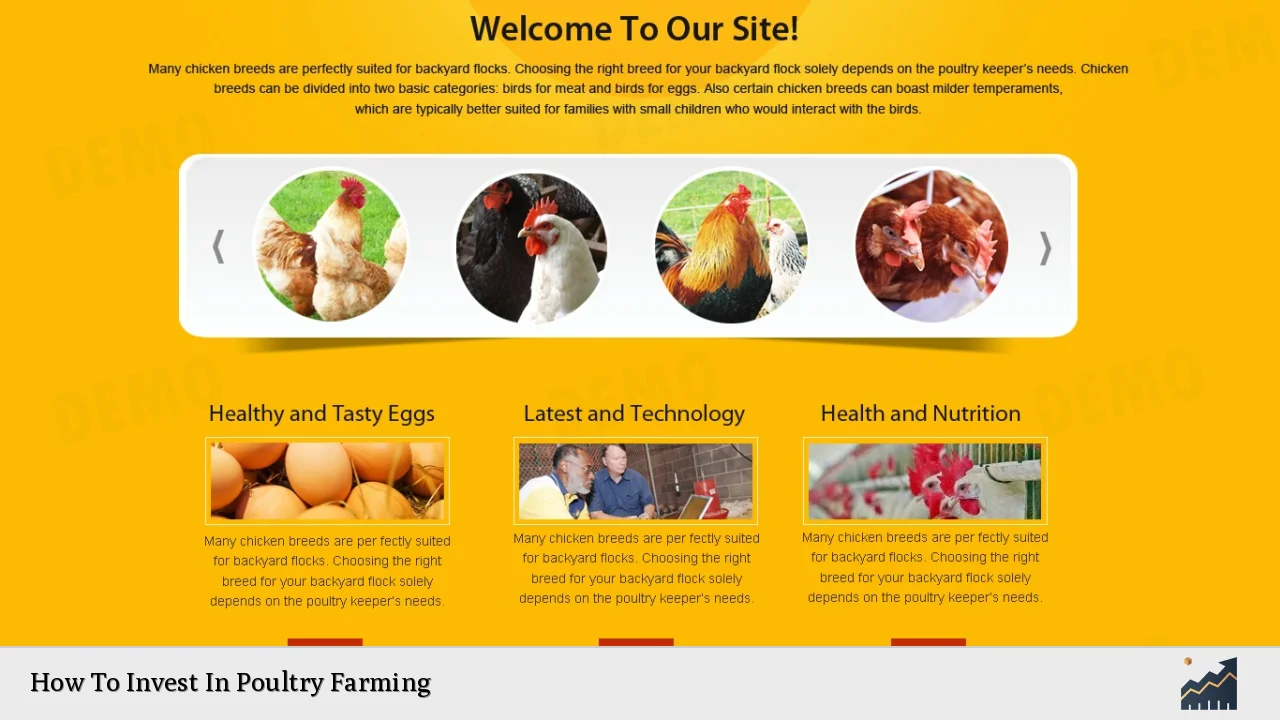Investing in poultry farming presents a lucrative opportunity for individuals looking to enter the agricultural sector. The global poultry market is experiencing steady growth, driven by rising consumer demand for chicken and eggs, making it an attractive investment avenue. This guide will provide a comprehensive overview of how to invest in poultry farming, covering market trends, implementation strategies, risk considerations, regulatory aspects, and future outlook.
| Key Concept | Description/Impact |
|---|---|
| Market Growth | The global poultry market is projected to grow from $322.53 billion in 2023 to $434.27 billion by 2030, with a CAGR of 3.8% from 2024-2030. |
| Investment Costs | Start-up costs for poultry farming can range from $5,000 to $100,000 depending on the scale and type of operation. |
| Profit Potential | With proper management, profit margins can reach 5-15%, influenced by production efficiency and market pricing. |
| Funding Sources | Investors can explore various funding options including bank loans, government grants, venture capital, and crowdfunding. |
| Regulatory Compliance | Poultry farming is subject to stringent regulations regarding food safety and animal welfare which can incur additional costs. |
Market Analysis and Trends
The poultry industry is one of the fastest-growing sectors in agriculture. According to recent reports, global poultry consumption is expected to increase significantly due to changing dietary preferences towards protein-rich foods. The demand for poultry products is projected to grow at an annual rate of approximately 2.5% to 3% in 2024, recovering from slower growth rates in previous years.
Key trends influencing the market include:
- Health Consciousness: Increasing awareness of health benefits associated with poultry consumption is driving demand.
- Sustainability: Consumers are favoring sustainably produced poultry, prompting farms to adopt eco-friendly practices.
- Technological Advancements: Innovations in breeding, feed efficiency, and disease management are enhancing production capabilities.
Implementation Strategies
To successfully invest in poultry farming, consider the following strategies:
- Business Planning: Develop a robust business plan that outlines your operational goals, target market analysis, financial projections, and risk management strategies.
- Choosing the Right Type of Poultry: Decide whether to focus on broilers (meat production), layers (egg production), or both. Each type has different management requirements and profitability potential.
- Location Selection: Choose a location with favorable climate conditions and access to markets. Proximity to suppliers and customers can significantly reduce operational costs.
- Infrastructure Development: Invest in necessary infrastructure such as housing for birds, feeding systems, and waste management facilities. Proper design enhances productivity and animal welfare.
- Quality Feed and Health Management: Prioritize high-quality feed and veterinary care to ensure optimal growth rates and minimize health risks among your flock.
Risk Considerations
Investing in poultry farming involves several risks that must be managed effectively:
- Market Volatility: Fluctuations in feed prices and consumer demand can impact profitability. Effective forecasting and flexible pricing strategies are essential.
- Disease Outbreaks: Poultry farms are susceptible to diseases that can devastate flocks. Implementing biosecurity measures is crucial for disease prevention.
- Regulatory Changes: Compliance with evolving regulations can incur additional costs. Staying informed about local laws regarding animal welfare and food safety is necessary.
- Environmental Impact: Increasing scrutiny regarding environmental practices may require investments in sustainable technologies or practices.
Regulatory Aspects
Poultry farming is subject to various regulations aimed at ensuring food safety and animal welfare. Key regulatory considerations include:
- Licensing Requirements: Obtain necessary permits for operating a poultry farm which may include environmental assessments.
- Health Regulations: Compliance with health standards set by governmental bodies (e.g., USDA in the U.S.) is mandatory.
- Animal Welfare Standards: Adhering to humane treatment standards for livestock is not only ethical but also legally required in many regions.
Investors should consult with legal experts or agricultural advisors to navigate these regulations effectively.
Future Outlook
The future of poultry farming appears promising due to several factors:
- Increased Protein Demand: As global populations grow and diets shift towards protein-rich foods, the demand for poultry products will continue to rise.
- Technological Innovations: Advancements in genetics and nutrition will likely improve production efficiency and profitability.
- Sustainability Initiatives: The industry is expected to see more investments in sustainable practices as consumers become increasingly environmentally conscious.
Overall, investing in poultry farming offers significant potential returns if approached with careful planning and strategic execution.
Frequently Asked Questions About How To Invest In Poultry Farming
- What is the initial investment required for starting a poultry farm?
The initial investment can range from $5,000 for small-scale operations up to $100,000 or more for larger farms depending on infrastructure needs. - How long does it take to see returns on investment?
Typically, investors can expect returns within 1-3 years depending on management efficiency and market conditions. - What are the most profitable types of poultry farming?
Broiler production tends to be more profitable due to quicker turnaround times compared to egg production. - What financing options are available for poultry farming?
Options include bank loans, government grants/subsidies, venture capital investments, crowdfunding platforms, or personal savings. - How do I ensure biosecurity on my farm?
Implement strict access controls, regular health checks for birds, sanitation protocols for equipment, and vaccination programs. - What are the key factors affecting profitability in poultry farming?
Production efficiency (feed conversion ratios), market prices for meat/eggs, operational costs (labor/feed), and disease management practices. - Are there any government subsidies available for poultry farmers?
Yes, many governments offer subsidies or grants aimed at supporting agricultural ventures including poultry farming. - What role does technology play in modern poultry farming?
Technology enhances efficiency through automation of feeding systems, climate control measures in housing facilities, and data analytics for performance monitoring.
Investing in poultry farming requires thorough research and strategic planning but offers substantial opportunities for profit given the right conditions and management practices.

